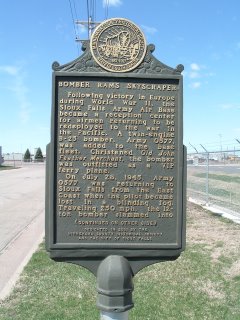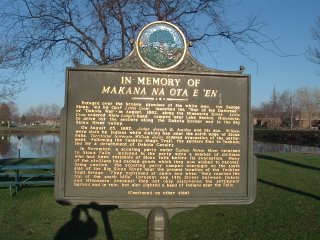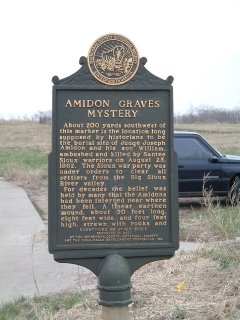Bomber Rams Skyscraper
The Army Air Base was home to thousands of soldiers during the war, and added much to the city's history; one such incedent is recorded on a marker just outside the main gate of the Air Guard base:

BOMBER RAMS SKYSCRAPER
Following victory in Europe during World War II, the Sioux Falls Army Air Base became a reception center for airmen returning to be redeployed to the war in the Pacific. A twin-engine B-25 bomber, Army 0577, was added to the base fleet. Christened Old John Feather Merchant, the bomber was outfitted as a VIP ferry plane.
On July 28, 1945, Army 0577 was returning to Sioux Falls from the East Coast when the pilot became lost in a blinding fog. Traveling 250 mph, the 12-ton bomber slammed into the 78th floor of New York's Empire State Building, then the world's tallest building. The point of impact was 975 feet above street level. Highly flammable aviation fuel exploded, unleashing a deadly fireball inside the skyscraper.
Killed in the tragic collision were the plane's 3 occupants and 11 people at work in the building. Concluding that fault for the accident was largely that of the pilot, the Army thereafter required more intensive transitional training for pilots returning from overseas combat duty.
DEDICATED IN 2001 BY THE
MINNEHAHA COUNTY HISTORICAL SOCIETY
AND THE CITY OF SIOUX FALLS

I had read about that accident before, and was surprised that there is a Sioux Falls connection. From what I remember of the story, there was much fear following the accident that the Empire State Building might collapse. But I guess they built 'em tough in those days, and it still stands today.
Edit: Thought I'd add a couple of links with pertinent information on the event memorialized in this marker. The "Official Website of the Empire State Building" has an article on the event (link), and Damn Interesting has a story about it as well (link). DI also hosts a recording of a Mutual News radio broadcast about the accident. Makes you feel like you were there!
It's interesting to note the discrepancy between the story told in this marker and that told by DI and the Empire State Building website. The marker states that the plane "was returning to Sioux Falls from the East Coast", but the others say that the plane was enroute to Newark, NJ, to pick up the CO of the Army Air Base. I think the latter is the more likely case, as it was only the pilot and two crewmen who were on the plane when it crashed. Not that the story told on the marker is likely to be revised or updated any time soon, but...




















